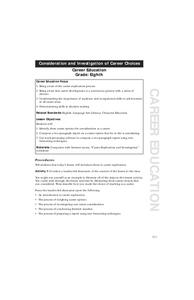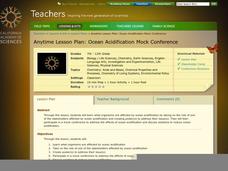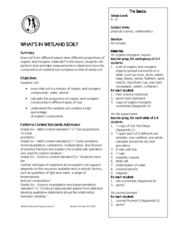iCivics
Step Four: Working with Websites
Almost every profession today relates to websites in some way! The resource tasks the class to fill out three individual graphic organizers to help them analyze each website they visit.
Curated OER
US Civil Rights Movement: Beginnings through the 60s
A real find for a U.S. History teacher, this presentation could supplement many class sessions about the Civil Rights Movement. Pictures of events, major figures, and "Whites Only" signs are striking and effective for even your most...
Curated OER
Rocks: Mineral Mixtures
A 22-slide set provides pretty much everything you need to teach the rock cycle except the actual specimens. All of the slides contain graphics or photographs to help describe the process, and most even have links to educational videos....
Learning for Life
Career Education
As part of a career exploration and investigation, learners research the Internet for possible career options and identify what type of educational preparation is required for those careers, as well as possible salary options,...
Do2Learn
Taking Turns
Whose turn is it? Keep track of individuals' turns with a turn-taking board. Applicable to every subject and classroom, the educational strategy provides pupils with structured expectations and endurance while awaiting their turn.
British Council
Unit 9: Email Etiquette
Manners matter! The ninth and final lesson in a series of career education and skills activities focuses on hitting a happy medium in business correspondence. Scholars master five simple rules for creating e-mails that are friendly,...
Curated OER
Shapes: Art or Geometry
Budding artists or mathematicians read about,and then draw, two very different shapes. Geometric and organic 2-D shapes are defined. Learners use the definitions to draw examples of each.
Curated OER
Graphic Organizing: Early American History
In collaborative groups, young US historians sort cards (each labeled with a single early American event or issue) according to which of the first four presidents was leading the country at the time. Learners copy the events onto a...
Curated OER
The Road to Careers (Part 2)
Fourth graders discuss the ways people prepare for their careers. As a class, they discover the many options they have after graduating from high school. In groups, they use the internet to research the types of skills and education they...
Curated OER
Lead Up Skills fo Tchoukball
A simple lesson to practice the throwing and catching skills for the game of Tchoukball. There are several warm-up activities to have the class practice tossing a ball around. Then the main drill is organized much like a basketball...
Curated OER
Jewel of the Earth
Students investigate several organisms, set sticky traps to collect them, and attempt to identify and classify them using a variety of sources. The origins of the organisms are traced and their adaptive features examined.
Curated OER
Environmental Conditions: Friend or Foe
Students research and answer questions on how organisms are classified and how their needs are met through their environment. They work in small groups and create a poster, chart, rap, PowerPoint, or brochure demonstrating how organisms...
Curated OER
Do You Have the Guts?
Seventh graders Name and locate the major internal organs of the human body and the frog. Students virtually dissect a frog and compare organs to the human organs. Students draw illustrations of their learnings.
Curated OER
Pest Populations: A Game of Survival
Students identify and classify populations of pests in the home, school and community. They recognize the specific conditions needed for the survival of an organism considered a pest and list tactics for control measures.
Curated OER
Water: H2O = Life
In this earth science worksheet, students explore and describe animals and their adaptations, including their habitats, physical characteristics, and competing organisms. They also explore and describe how others use water around the...
California Academy of Science
Ocean Acidification Mock Conference
In a comprehensive role playing activity, teens play the parts of different stakeholders in the realm of acidic oceans. They research, debate, and create a presentation from the perspective of either ocean organisms, the fishing...
Smithsonian Institution
A Ticket to Philly—In 1769: Thinking about Cities, Then and Now
While cities had only a small fraction of the population in colonial America, they played a significant role in pre-revolutionary years, and this was certainly true for the largest city in the North American colonies: Philadelphia. Your...
Curated OER
Liver Roulette: Who Gets the Liver?
Students complete various exercises and activities as they examine the procedures involved in organ transplants and the ethical issues surrounding organ donations.
Curated OER
Design a Reef!
Students explore coral reef ecosystems. In this ecosystems science lesson, students research coral reef ecosystems to determine the major functions the participating organisms must perform. Students construct a miniature...
Curated OER
Comprehension of Word Problems
Learners solve word problems using a graphic organizer. In this problem solving lesson, students are introduced to the included graphic organizer and are taught how to use it for solving word problems. Learners write the required...
Curated OER
What's in Wetland Soil?
Students examine the organic and inorganic components of soil. In this environmental science lesson, students identify the factors that influence soil formation. They collect soil samples, conduct tests, and analyze the results.
Curated OER
Food Chains and Food Webs
Fourth graders study intertidal organisms and their role in the food web. In this food web lesson, 4th graders read the book The Sea That Feeds Us and discuss food webs. Students study pictures of intertidal creatures and discuss their...
Curated OER
What Does a Philanthropic Organization Do?
Students explore the work of a local nonprofit organization and define "nonprofit" and "profit" organizations. They identify examples of three local philanthropic organizations and work together to draw conclusions about a non-profit...
Curated OER
Importance of the Ear
In this biology worksheet, students identify six important reasons of the ears in humans. They complete a graphic organizer filling in each of 6 circles with one reason of importance.























